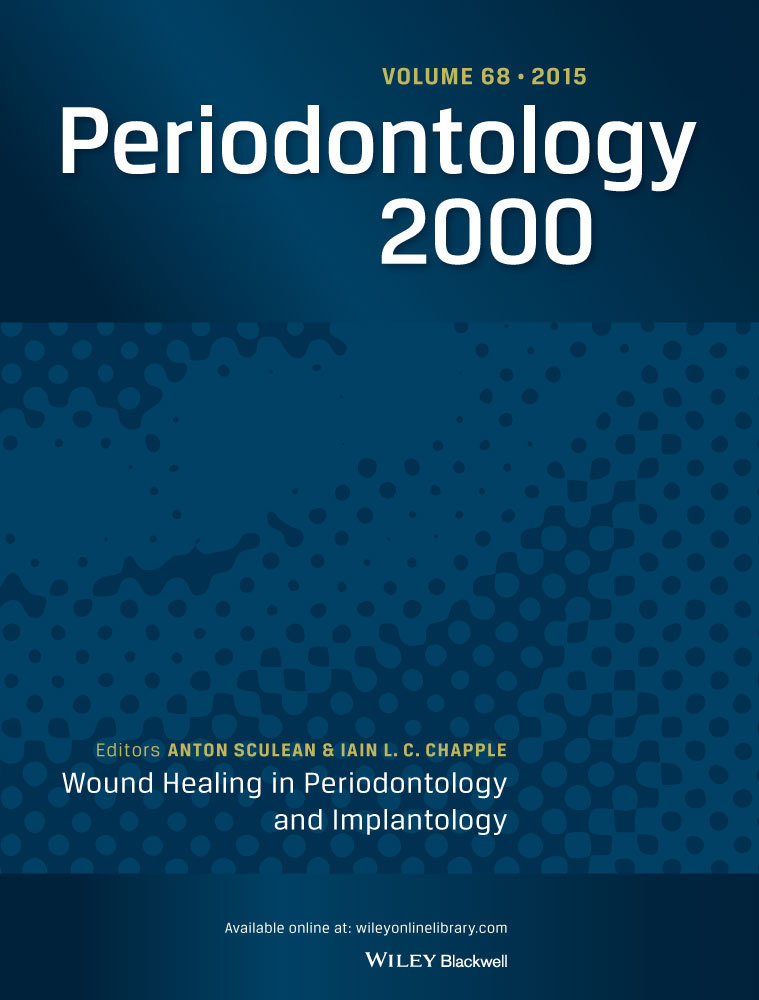Long-term surgical treatment outcomes of peri-implantitis.
IF 15.7
1区 医学
Q1 DENTISTRY, ORAL SURGERY & MEDICINE
引用次数: 0
Abstract
BACKGROUND To assess the long-term results of the surgical treatment of peri-implantitis by means of clinical, radiographic outcomes, and whenever possible, a composite definition of disease resolution. Furthermore, this review aimed at evaluating the prognostic indicators of long-term disease recurrence. METHODS A systematic screening was conducted to identify long-term clinical studies (≥5 years) on the surgical therapy of peri-implantitis. Data pertinent to study methodology, surgical intervention and clinical and radiographic outcomes were retrieved from the original studies. Qualitative assessment was performed. RESULTS Overall, 17 long-term studies were included in the qualitative synthesis. Due to the heterogeneity, quantitative analysis was not suggested. The mean disease resolution rate was 58.6%. The mean progressive bone loss arrestment (>1 mm) at the latest follow-up following therapy was reached in 69.6%. Resolution of bleeding on probing at the latest follow-up was achieved in 59.9%. The need for retreatment was deemed in 27.2% of the cases. Disease resolution following a second attempt was seldomly evaluated. The implant survival rate resulted in 88.6% (range: 75%-100%). The odds for disease recurrence following surgical treatment of peri-implantitis were ∼8× higher when residual pathogenic pockets were present during follow-up. Moreover, the extent of bone loss, the width (<2 mm) of keratinized mucosa following surgical treatment, and implant surface (modified) influenced disease recurrence. CONCLUSION The surgical treatment of peri-implantitis yields to favorable outcomes in the long-term. Data suggest that the long-term disease resolution is ∼60% under supportive peri-implant care, while ∼70% exhibit progressive bone loss arrestment. Hence, the need for retreatment is not infrequent. Residual pockets (≥6 mm) following surgical therapy and the advanced extent of bone loss imply a risk for disease recurrence. CLINICAL RELEVANCE These findings suggest that the surgical treatment of peri-implantitis is effective in the long-term in patients enrolled in supportive peri-implant therapy. However, its predictability can be interfered in scenarios exhibiting advanced lesions or in those that display residual deep pockets following therapy.种植体周围炎的远期手术治疗效果。
背景:通过临床、影像学结果,以及可能时疾病消退的综合定义,评估种植体周围炎手术治疗的长期效果。此外,本综述旨在评估长期疾病复发的预后指标。方法系统筛选种植体周围炎手术治疗的长期临床研究(≥5年)。从原始研究中检索与研究方法学、手术干预、临床和影像学结果相关的数据。进行定性评价。结果定性综合共纳入17项长期研究。由于异质性,不建议进行定量分析。平均疾病治愈率为58.6%。在治疗后的最新随访中,平均进行性骨丢失停止(>.1 mm)达到69.6%。59.9%的患者在最近一次随访中解决了探查出血问题。27.2%的病例认为需要再治疗。很少评估第二次尝试后的疾病解决情况。种植体成活率为88.6%(范围:75%-100%)。手术治疗种植体周围炎后疾病复发的几率在随访期间存在残留致病性口袋时高出约8倍。此外,骨丢失程度、手术治疗后角质化粘膜的宽度(< 2mm)和种植体表面(改良)影响疾病复发。结论手术治疗种植体周围炎远期疗效良好。数据表明,在支持种植体周围护理下,长期疾病的缓解率为~ 60%,而~ 70%表现出进行性骨质流失停止。因此,需要再处理的情况并不少见。手术治疗后残留的骨袋(≥6mm)和骨质流失的严重程度意味着疾病复发的风险。临床相关性这些研究结果表明,手术治疗种植周炎对参加支持性种植周治疗的患者长期有效。然而,它的可预测性可能会在出现晚期病变的情况下受到干扰,或者在治疗后显示出残留的深层口袋。
本文章由计算机程序翻译,如有差异,请以英文原文为准。
求助全文
约1分钟内获得全文
求助全文
来源期刊

Periodontology 2000
医学-牙科与口腔外科
CiteScore
34.10
自引率
2.20%
发文量
62
审稿时长
>12 weeks
期刊介绍:
Periodontology 2000 is a series of monographs designed for periodontists and general practitioners interested in periodontics. The editorial board selects significant topics and distinguished scientists and clinicians for each monograph. Serving as a valuable supplement to existing periodontal journals, three monographs are published annually, contributing specialized insights to the field.
 求助内容:
求助内容: 应助结果提醒方式:
应助结果提醒方式:


